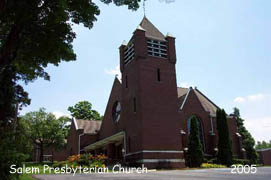Location
152 Washington College Road, Limestone, Tennessee.
History
Salem Presbyterian Church was founded in 1780 by the Reverend Samuel Doak. Dr. Doak was of Scotch-Irish heritage, a graduate of Princeton and licensed to preach by Hanover Presbytery in 1777. Reverend Doak rode into East Tennessee in 1780 and reportedly came upon a group of men felling trees near Little Limestone Creek. He preached a sermon from the back of his horse and from this meeting, Salem Church, the first Presbyterian Church in the state, came into being.
Alexander Mathes I, an early pioneer, urged Doak to stay and he donated fifty acres of land to him to be used for the establishment of a church and school. Salem Church and Martin Academy (now Washington College Academy) were founded. The original church building was constructed of logs at the west corner of what is now Harris Hall on the Academy campus, and east of Salem Cemetery. In 1825 the first church building was replaced with a brick building erected northeast of Harris Hall.
The present church building was constructed in 1894-95 when the 1825 brick building became too small to house the growing congregation. A new site was chosen at the south side of the school campus. In 1894 a deed was drawn up describing the church property boundaries and recorded in Register of Deeds in Jonesborough. The official name of the church was changed from Salem Church to Salem Presbyterian Church by the approval of a new charter in 1899. The cost of the new building was $10,073.76. Church records show that James H. Willis, a contractor form Greeneville, TN, served as superintendent of the project. Church members and students of the school helped whenever they could. The brick for the church was burnt on the premises by the firm of C.A. Coile of Greenville, TN. The logs for the beams in the sanctuary were donated by James Miller. Mrs. Nettie Fowler (Cyrus) McCormick donated $3,500 and hired A. Page Brown to design the church.
The building is constructed in Richardson Romanesque style, and has a number of distinctive exterior features. The bricks vary somewhat from a general length of 8 inches and laid in common bond pattern. A water table band of stone extends around the building. The original slate roof is still in place and stone coping caps the walls around the rooflines.
Stained glass windows are on all sides of the building. In front of the church, a rose window eleven feet in diameter is featured. The west side of the building is dominated by a large stained glass window which is flanked on either side by two smaller stained glass windows separated by small buttress. On the east elevation are four semi-circular arched stained glass windows and a smaller segmental arched stained glass window on the south end.
To the west of the main entrance portico is a square bell tower rising somewhat higher than the central gable. The original bell is still in use.
The sanctuary has English style Craftsman wood truss structure which is made of two hand-hewn unjointed white pine beams of approximately fifty feet in length bearing the marks of the adz, which are clearly visible, and supported by hand forged metal braces. The crossbeams are enhanced by modified square billet trim cut into the edge. Between 1945 and 1948, six chandeliers of Gothic design replaced the single hanging lamp. The sanctuary is entered via of three sets of double oak doors with egg shaped doorknobs.
Salem Presbyterian Church is on the National Register of Historical Places under criterion C for its architectural significance and under criterion A in social history for its association with the philanthropic endeavors of Nettie Fowler McCormick.
Pastors
A fairly complete list of pastors of Salem Church has been compiled with the help of the Mary Hardin McCown Collection located in the Washington County-Jonesborough Library. Mrs. McCown has listed the pastors from Samuel Doak to the year 1891; all were also presidents of Washington College (now Washington College Academy).
Rev. Samuel Doak, D.D., 1780-1818
Rev. John Whitfield Doak (1st son of Samuel), 1818-20
Rev. John V. Bovelle, 1821-29
Rev. James McLin, 1829-1838
Rev. Samuel W. Doak, D.D., (2nd son of Samuel), 1838-40
Rev. Joseph I. Foote, D.D., elected 24 Aug 1839; died 21 Apr 1840. [Rev. Foote was
thrown from his horse while enroute to the College and died before inauguration.]
Rev. Archibald A. Doak, 1840-50
Rev. E. Thompson Baird, D.D., 1850-52
Rev. Archibald A. Doak, D.D. (2nd term), 1853-56
Rev. Samuel Hodge, D.D. 1857-58
Misses Eva A. and G. Adda Telford, Principals, 1866-68
Rev. William B. Rankin, D.D., 1868-75
Rev. J.E. Alexander, D.D., 1877-83
Rev. J.W.C. Willoughby, D.D., 1883-1891
After 1891 and up until the present time, with a very few exceptions, the pastors of Salem Church were chosen independently of the school.
William S. Doak, 1875-1882
J.W.C. Willoughby, 1882-1896
H.G. Dension, 1897-1899
James M. Walton, 1901-1903
C.B. Clark, 1904-1910
J.C. Ritter, 1910-1915
Robert L. Houston, 1923-1929
J.T.W. Stewart, 1929-1941
Alexander M. Warren, 1941-1943
B.B. Lavender, 1944-1950
Richard R. Gilbert, 1950-1954
A.H. VanderBosche, 1955-1958
A.S. Caldwell, 1959-1961<
Bruffie Conner, 1961-1974
Howard Pusey, 1976-1982
Michael Fleenor, 1893-1991
Durl Edwin Odom, 1992 –
References:
Crawford, Earle W., Pioneer Missionary in East Tennessee: Samuel Doak, Jonesborough TN: Pioneer Printers, Washingotn College Academy, 1980.
Gibson, Jo Chapman, Salem Presbyterian Church, Johnson City TN: The Overmountain Press, 1992.
Kiener, John L., “Digging for Your Roots” Jonesborough Herald & Tribune, 16 March 2004, p. 7A.
Posted 12 Sep 2007

